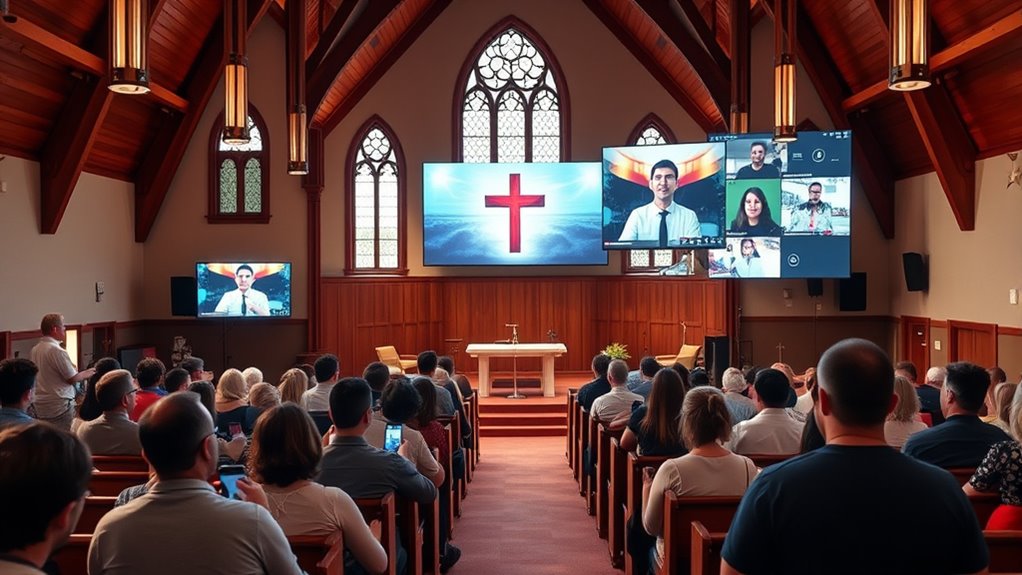A hybrid church combines in-person gatherings with online ministry to create a more accessible and engaging faith community. You can participate through live streams, online groups, and social media, extending connection beyond physical spaces. This model fosters community, offering spiritual growth opportunities for diverse needs while reaching people beyond geographic limits. It’s designed to be flexible, innovative, and resilient, ensuring your faith journey stays strong. Explore how this approach can transform your experience as you continue discovering more.
Key Takeaways
- Hybrid church integrates in-person and digital experiences to expand reach and foster spiritual growth.
- Combines community building through physical gatherings and ongoing online engagement.
- Offers flexible ministry options to accommodate diverse needs and remove geographic barriers.
- Utilizes multimedia and interactive tools to create accessible, engaging spiritual content.
- Aims to build a vibrant, inclusive community that reflects faith’s love through combined physical and virtual presence.

Hybrid church models are transforming how congregations gather and connect by blending in-person and digital experiences. This approach allows you to reach more people while creating meaningful opportunities for spiritual growth and community. Digital engagement plays a vital role here, as it enables you to connect with members anytime and anywhere. Whether they’re tuning into a live stream, participating in online small groups, or engaging with social media content, digital tools help maintain a continuous sense of community beyond the physical church building. You can foster a vibrant, inclusive environment that adapts to the diverse needs of your congregation, making faith accessible to those who might not attend in person regularly.
Hybrid church models blend in-person and digital experiences to expand reach and foster vibrant, inclusive communities beyond the physical space.
As you implement hybrid models, you’ll notice that community building becomes more intentional and dynamic. In-person gatherings provide a sense of closeness and shared experience, but digital engagement extends that sense of community throughout the week. You can use online platforms to encourage prayer requests, share testimonies, or host virtual events that keep members connected between services. This ongoing interaction helps deepen relationships and cultivates a sense of belonging, even for those who primarily engage online. By integrating online and offline activities seamlessly, you empower your congregation to support one another more consistently and authentically.
Furthermore, the flexibility of hybrid church models allows you to adapt your ministry to different circumstances. When in-person attendance drops due to health concerns or other barriers, digital engagement guarantees that your community remains active and engaged. You can also reach new audiences beyond your geographic location, offering sermons, classes, and fellowship opportunities through digital channels. This expanded reach can invigorate your community, bringing in fresh perspectives and diverse voices that enrich your shared faith journey. The key is to leverage technology thoughtfully, making sure your digital interactions feel personal and intentional rather than superficial.
In addition, hybrid church models encourage innovation in how you deliver ministry. You can incorporate multimedia content, interactive online classes, and live Q&A sessions that boost engagement and participation. These tools make spiritual learning more accessible and engaging for people of all ages. By prioritizing digital engagement and community building, you create a resilient, responsive church that can thrive regardless of physical limitations. Ultimately, combining in-person and online ministry isn’t just about convenience; it’s about fostering a connected, vibrant community that reflects the inclusive love at the heart of your faith.
Frequently Asked Questions
How Do We Measure Success in Hybrid Ministry?
You measure success in hybrid ministry by tracking pastoral engagement and attendee retention. If you see active participation both in person and online, it shows your community feels connected. Regularly engage with attendees, gather feedback, and monitor attendance trends across platforms. When engagement increases and people stay committed, it indicates your hybrid approach effectively nurtures spiritual growth and community, making your ministry truly impactful.
What Technology Tools Are Essential for Effective Hybrid Services?
You need reliable streaming platforms like YouTube or Vimeo for virtual engagement and easy access. Incorporate tech tools such as OBS or Ecamm for seamless tech integration during services. Use interactive apps like chat features or polls to foster participation. Additionally, consider a good audio system and multiple cameras to improve visual quality. These tools help guarantee your hybrid services are engaging, accessible, and smoothly coordinated for everyone involved.
How Can Small Churches Implement Hybrid Models Affordably?
Imagine your small church hosting a hybrid service with minimal costs. You can start by reallocating existing resources, like using your current sound system for live streaming. Volunteer coordination becomes essential—train a few dedicated members to manage online platforms. This approach keeps expenses low while expanding your reach. Focus on simple tech tools and clear roles to implement a hybrid model affordably and effectively, engaging both in-person and online congregants.
How Do We Foster Community Among Online and In-Person Attendees?
You foster community among online and in-person attendees by encouraging virtual engagement through live chats, small group discussions, and interactive prayer sessions. Make personal connections by welcoming newcomers warmly, remembering names, and creating opportunities for both groups to share experiences. Use technology to bridge gaps, like shared video messages or hybrid events, so everyone feels included and valued, strengthening the sense of belonging across your entire church community.
What Are Common Challenges in Transitioning to Hybrid Church?
You face challenges like maintaining digital engagement and ensuring your team has adequate pastoral training for both in-person and online settings. Shifting requires adapting your technology, balancing in-person and virtual interactions, and fostering community across platforms. You also need to invest in training staff to effectively serve digital attendees and create seamless experiences. Overcoming these issues involves strategic planning, ongoing training, and a focus on building authentic connections in both environments.
Conclusion
Just like a well-tended garden thrives with both sun and shade, your hybrid church nurtures growth by blending in-person and online ministry. Imagine a member who once felt disconnected finds community through your digital outreach, blossoming into a vibrant part of your congregation. Embracing this balance isn’t just strategy; it’s planting seeds that will flourish for generations. Keep cultivating both spaces, and watch your church’s love and impact grow beyond what you thought possible.










